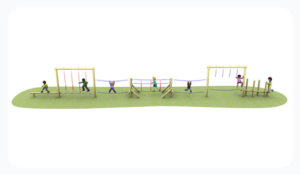
Learn More About...

Who are Fawns?
We're the longest-established school playground equipment provider around - we know a thing or two about playground design.
With family-ran roots, schools, MATs, nurseries and parish councils trust us to create outdoor playgrounds with a purpose.
Sensory circuit ideas for schools: Outdoor edition
Sensory circuits help regulate children, giving them the sensory feedback they seek. When crisis is bubbling, taking time out to help a child regulate can get them back in a ‘green’ learning space. We share easy sensory circuit ideas to try in your school.

What are sensory circuits?
Sensory circuits usually consist of activity sequences that aim to stimulate or calm one or more sensory systems. Anyone can participate in a circuit to organise their sensory input regardless of age. It can be useful for neurodivergent children and those with sensory processing differences.

Sensory circuits are organised into three activity areas:
- Alerting activities.
- Organising activities.
- Calming activities.
These activities should flow into each other and be tailored to the type of sensory circuit the child needs to organise their sensory input. For example, one child may need to stimulate their vestibular sensory system through balance activities, while another may prefer activities where they control the movements and risk levels more (like swings). It is recommended to have 2 alerting activities, 2 organising and 1 calming activity to finish. The pupil can repeat the circuit as many times as necessary.
Alerting activities for sensory circuits.
Alerting activities for sensory circuits are a way to wake up and stimulate the body. These exercises often increase alertness in children.
- Skipping
- Jumping
- Running
- Bouncing
- Crawling
- Star jumps
- Dancing
- Climbing up a net
- Swinging
- Monkey bars
Organising activities for sensory circuits.
Organising sensory activities aim to channel focus and help children to organise their sensory input.
- Throwing a ball into a hoop
- Walking across moving planks
- Balancing on pick-up sticks
- Balancing on a tightrope
- Swinging across equipment
- Blowing bubbles
- Swinging on uneven bars (or hanging upside down)
- Running through tyres

Calming activities for sensory circuits.
These activities can be deep-pressure activities, relaxing exercises and a lower level of cardio and exertion than the alerting and organising sensory circuits.
- Deep breathing
- Yoga and stretching
- Weighted blanket
- Low movement on a bird’s nest swing
- Hanging on parallel bars
- Slow wall push-ups
- Chair push-ups (slowly)
- Lying down on hard materials like a bench or in a tunnel
What makes a good sensory circuit in schools?
Sensory circuits in schools must meet several factors to be cost-effective and practical. Mainstream schools and SEND settings may have differing levels of flexibility with circuit use and equipment. Schools should consider the following when planning and creating a sensory circuit:
Meeting the sensory needs of the children.
There are 8 sensory systems that can be supported through activities and exercises. Ensuring the sensory circuit you create for your school pupils meets their needs can be tricky. How do you cater to everyone’s needs? Well, in short, you can’t. What you can do is have sensory circuits that are designed to have modules to meet different needs.
Building intensity throughout the circuit.
Children with sensory and SEMH needs may have significantly reduced frustration tolerances. It can reduce participation levels if the starting point of a sensory circuit is too challenging. Aim to have ‘heavy work’ exercises or activities in the middle of the sequence; this gives the proprioceptive sensory system feedback. There are multiple benefits of physical play for children with SEMH, including improving mental health.
Opportunities for pupils to win.
The circuit activities should meet the pupil’s sensory needs and be enjoyable, making them more likely to repeat the exercises. Allow children the opportunity to win regularly, and limit the length of the circuit to allow them to complete it successfully. Even encourage them to support a peer through completing sections, further developing communication and interaction skills (one of the best benefits for playing outdoors).
Safety first.
A sensory circuit can include balancing activities, bodyweight heavy work, climbing and crawling. It is important to make sure any outdoor play equipment you use to create a permanent sensory circuit is safe and well-maintained.
19 Sensory circuits ideas for schools: outdoor edition.
So, let’s get to it; here are some of our favourite sensory circuit ideas for your school. We have separated them into singular activities. Structuring the activities in the suggested alerting, organising, and calming sequence can benefit emotional regulation. Having outdoor play equipment like a trim trail designed to be a sensory circuit can be the safest and least time-consuming method of creating a circuit in your school.
Contact our experts to get your school’s tailored trim trail design.
- Crawling through a tunnel
- Rolling on top of a yoga or gym ball
- Bouncing on a mini trampoline
- Balancing on a wobbly plank
- Swinging on a swing (a bird’s nest swing can be calming and alerting depending on speed and height)
- Skipping with a rope (independently or with a few friends)
- Tyre rolling
- Balancing on a tight rope (having the additional rope at chest or head height helps for safety and securing that win)
- Climbing up or over a scramble net (travelling across the net also gives great sensory feedback)
- Pushing or pulling (a log traverse is great for this, as the child is pushing and pulling their body weight)
- Monkey bars
- Different textured ground like bark, AstroTurf, DuraLawn, and grass
- Breathing or mindfulness exercises (you can find lots of ideas here)
- Short lap of the playground on a space hopper (take care of children displaying coordination difficulties for safety)
- Sausage rolling down a hill mound (this can give feedback to the tactile sensory system with body weight pressure and can act similarly to a weighted vest)
- Balancing on pick-up sticks equipment or balance beams
- Following a chalk trail or tape line on the playground
- Barefoot across the grass or whilst engaging in sand or water play
- Simon says with movements for the proprioceptive system like hop, jump, crawl
- Gustatory (taste) activities like growing and eating vegetables (this is a longer-term activity and can be useful to tailor to those with particular gustatory needs)
Other articles you may be interested in
How to Use (and get the most from) Your Outdoor Sensory Play Equipment
How to Create a Sensory Garden In Your School
Seven inclusive play activities to promote sharing and turn taking
About the Author - Emily Robinson


Other Blog Posts


© Playtime By Fawns | 2025 website developed & maintained by digidoda








